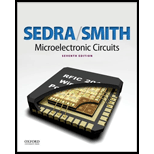
Concept explainers
The intrinsic carrier
Answer to Problem 3.1P
The value of intrinsic carrier
Explanation of Solution
Calculation:
The intrinsic carrier density is given by
Here,
The fraction of atom ionized is calculated as,
Here,
For
Substitute
Solve it further as
Substitute
For
Substitute
Solve it further as
Substitute
For
Substitute
Solve it further as
Substitute
For
Substitute
Solve it further as
Substitute
For
Substitute
Solve it further as
Substitute
Want to see more full solutions like this?
Chapter 3 Solutions
Microelectronic Circuits (The Oxford Series in Electrical and Computer Engineering) 7th edition
- Find the resistivity of a. p-type silicon with NA = 10^10 /cm^3. Determine the value of the concentration of minority charges. CONSTANTS FOR SILICON q= un = Hp = ni = V₂ = 1.6×10-19 C 1350 cm²/Vs 480 cm²/Vs 1.5×10¹⁰ /cm³ 26 mVarrow_forwardConsider an n-type silicon for which the dopant concentration Np= 1016/cm. Find the electron and hole concentrations at T=350 K. electron = 1016/cm³ & holes= 17.22 × 106 cm3 electron = 2.25 × 104/cm3 & holes= 2.25 x 104/cm3 electron = 17.22 × 100 /cm³ & holes= 1016/cm3 electron = 106/cm3 & holes= 1016 cm3arrow_forwardAt a temperature of 27 Celsius in silicon, the intrinsic carrier concentration is 1.5 x 1010 /cm³. What is the intrinsic carrier concentration if the temperature is increased to 48 Celsius?arrow_forward
- Find values of the intrinsic carrier concentration ni for silicon at -55°C. 1.5 x 1010 carriers/cm3 O 5 x 1010 carriers/cm3 2.7 x 106 carriers/cm2 2.7 x 106 carriers/cm3arrow_forward(1-5) The mobilites of free electrons and holes in pure Germanium are 0.33 and 0.18m/v-s corresponding values for pure silicon are 0.13 and 0.05 m/v-s respectively. intrinsic conductivity for both the materials Assume n=2.5x 10m for Silicon at room temperature. (1-6) Calculate the donor corcentertion in N-type Germanium having resistivity of 100 q=1.6x 10" c and pa 0.36m/v-s. the Find the values of 10"/m for Germanium and ni=1.5x Sam takearrow_forwardQ7/ Silicon has a conductivity of 5 x 10-4 (N.m)-1 when pure. How many indium atoms/m3 are required so that the conductivity of 200 (N.m)-1 could be achieved in silicon using indium as an impurity? Given that the mobility of holes in silicon is 0.05 and of electrons is V. Sec m2 0.13 V. Secarrow_forward
- Consider an p-type silicon for which the dopant concentration Np = 1018/em3. Find the electron and hole %3! concentrations at T 350 K. electron = 1018 cm3, & holes= 2.25 x 102/cm3 ст electron = 2.25 x 102/cm3 & holes= 2.25 x 104/cm3 104 /em3 electron = 1018/cm3 & holes= 10o18 cm3 electron = 17.22 x & holes= 1018 cm3 %3Darrow_forwardSilicon is doped with a boron concentration of 4×1018/cm3. Is boron a donor or acceptor impurity? Find the electron and hole concentrations at 300 K. Is this material n-type or p-type? Find the electron and hole mobilities. What is the resistivity of the material?arrow_forwardQuestion one: A- -E E, 0.164V Consider a silicon crystal at 300° K doped with arsenic atoms. Depending on the following figure, find the equilibrium electron and hole concentration n, and p.. Given n¡ = 1.45 *101º cm³. -E,arrow_forward
- Departments ETC CIMS Determine the current Ir1, Ir2, Ir3 in mA and the voltage across R1 for the network shown in the figure if E=20 V. Assume diode to be Germanium.( R1=5.2kOhm, R2 2.2kOhm, R3=1.8kOhm) RI R2 R3 IR1 IR2 IR3 VR1arrow_forwarddetermine the fractional of total electrons still in the donor states at T= 300K. Assume Silicon is doped with phosphorous to a concentration of N=1014 cm³. [The ionization energy of donor electrons is 45 meV and Nc=2.8x1019 cm³] ww n www 0.029% 0.02% 0.2% 0.04%arrow_forwardÎNGİLİZCE TÜRKÇE RUSÇA An impurity like antimony (Sb) has five electrons in its outer shell. When there are Sb impurities in silicon,. Please choose one: ahiptir. a. A n-type material is created b. the crystal will be negatively charged C. none of the above D. both of the above 73:11 30.04.2021arrow_forward
 Delmar's Standard Textbook Of ElectricityElectrical EngineeringISBN:9781337900348Author:Stephen L. HermanPublisher:Cengage Learning
Delmar's Standard Textbook Of ElectricityElectrical EngineeringISBN:9781337900348Author:Stephen L. HermanPublisher:Cengage Learning Electricity for Refrigeration, Heating, and Air C...Mechanical EngineeringISBN:9781337399128Author:Russell E. SmithPublisher:Cengage Learning
Electricity for Refrigeration, Heating, and Air C...Mechanical EngineeringISBN:9781337399128Author:Russell E. SmithPublisher:Cengage Learning

